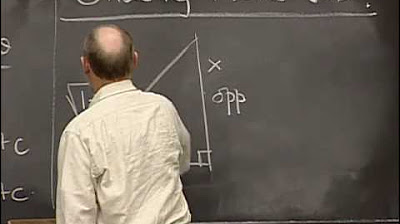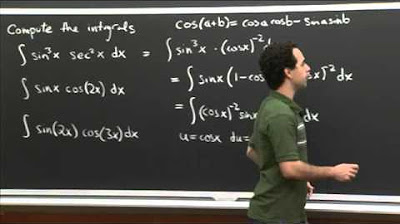Lec 27 | MIT 18.01 Single Variable Calculus, Fall 2007
TLDRThis MIT OpenCourseWare lecture, delivered by Professor Miller, delves into trigonometric integrals and substitutions. The professor begins with a review of trigonometric identities, focusing on the circle's unit radius and basic trig functions. He then introduces the concept of trig substitutions to simplify integrals, demonstrating their application through various examples. The lecture covers integrals of the form sin^n(x) cos^n(x) dx, highlighting the 'easy case' with odd exponents and the 'harder case' with even exponents. The professor also explores the use of half-angle formulas to tackle more complex integrals. Finally, he applies these concepts to a geometric problem involving the area of a sector cut from a circle, showcasing the power of trigonometric substitutions in solving real-world problems.
Takeaways
- 📚 The lecture is focused on trigonometric integrals and substitutions, with an emphasis on their applications in mathematics.
- 👨🏫 Professor Miller is the substitute teacher for the day, covering the topic of trig integrals and substitutions.
- 🔄 Trigonometry is based on the unit circle and fundamental trig identities are essential tools in solving integrals involving trigonometric functions.
- 🧩 Basic trig identities such as sin^2(θ) + cos^2(θ) = 1 and double angle formulas are repeatedly used throughout the lecture.
- 🔑 The half-angle formula is introduced as a method to express cos(θ) in terms of cos(2θ), which is useful for simplifying powers in trigonometric expressions.
- 📈 The lecture covers integrals of the form sin^n(x)cos^n(x)dx, which are particularly important in areas like Fourier series.
- 🎯 An easy case for these integrals is when at least one exponent is odd, allowing for straightforward substitution and integration.
- 🔍 The substitution u = sin(x) simplifies the integral of sin^n(x)cos(x)dx by transforming it into a polynomial integral.
- 📉 For more complex cases with only even exponents, the half-angle formula is used to reduce the powers and simplify the integral.
- 📐 The application of trigonometric integrals is demonstrated through a geometric problem involving the area of a 'tab' cut from a circle with radius 'a' and height 'b'.
- 📈 The area under a circular arc is calculated using the integral of the square root of (a^2 - y^2) with respect to y, which is transformed using trigonometric substitution.
Q & A
What is the main topic discussed in the video?
-The main topic discussed in the video is trigonometric integrals and substitutions, with a focus on integrating expressions involving powers of sine and cosine functions.
What is the significance of the circle with radius 1 centered at the origin in trigonometry?
-The circle with radius 1 centered at the origin is fundamental in trigonometry because it provides a geometric interpretation of the sine and cosine functions. The coordinates of a point on the circle at an angle theta from the x-axis are given by (cos(theta), sin(theta)).
What trigonometric identities are highlighted at the beginning of the lecture?
-The lecture highlights the Pythagorean identity, sin^2(theta) + cos^2(theta) = 1, and the double angle formulas, cos(2theta) = cos^2(theta) - sin^2(theta) and sin(2theta) = 2sin(theta)cos(theta).
What is the half-angle formula, and how is it used in the lecture?
-The half-angle formula is used to express cos(theta) in terms of cos(2theta). It is given by cos^2(theta) = (1 + cos(2theta))/2 and sin^2(theta) = (1 - cos(2theta))/2. In the lecture, it is used to eliminate powers from sines and cosines in the process of integrating trigonometric functions.
How does the lecturer simplify the integral of sin^n(x)cos^m(x) dx when at least one exponent is odd?
-When at least one exponent is odd, the lecturer simplifies the integral by using a substitution method. For example, if m = 1, the substitution u = sin(x) is used, which transforms the integral into a simpler form involving u^n and du, making it easier to integrate.
What is the strategy for integrating expressions of the form sin^n(x)cos^m(x) dx when both exponents are even?
-When both exponents are even, the strategy involves using trigonometric identities to reduce the powers of sine and cosine. The half-angle formula is particularly useful in this case to rewrite even powers of sines and cosines in terms of simpler expressions.
Can you provide an example of how the lecturer uses trigonometric identities to simplify an integral?
-An example given in the lecture is the integral of sin^3(x). The lecturer uses the identity sin^2(x) = 1 - cos^2(x) to rewrite sin^3(x) as (1 - cos^2(x))sin(x) and then proceeds with a substitution u = cos(x), transforming the integral into a simpler form that can be solved.
What is the purpose of back substitution in the process of integrating trigonometric functions?
-Back substitution is the process of replacing the substitution variable (like u) with the original variable (like x or theta) after performing the integration. It is done to return the solution to the original variable space, making the final answer more meaningful and understandable in the context of the original problem.
How does the lecturer approach the problem of finding the area of a tab cut from a circle with radius 'a' and height 'b'?
-The lecturer approaches this problem by considering the area as an integral of x dy over the region, where x is expressed in terms of y using the equation of the circle x^2 + y^2 = a^2. The lecturer then makes a trigonometric substitution, y = a sin(theta), to simplify the integral into a form that can be easily solved.
What is the final expression for the area of the tab cut from the circle using trigonometric integration?
-The final expression for the area of the tab, obtained through trigonometric integration, is a^2 theta_0 / 2 + b * sqrt(a^2 - b^2) / 2, where theta_0 is the angle corresponding to y = b, which can be found using arcsin(b/a).
Outlines
📚 Introduction to Trigonometry and Integrals
Professor Miller begins the lecture by introducing trigonometric integrals and substitutions, emphasizing the importance of understanding trigonometry basics. He uses a unit circle to explain the coordinates related to an angle theta and reviews essential trigonometric identities, such as sin^2(theta) + cos^2(theta) = 1. The professor also introduces the half-angle formulas, which are crucial for simplifying trigonometric expressions and integrals.
🔍 Trigonometric Identities and Integrals
The professor continues by delving deeper into trigonometric identities, focusing on the integrals of sine and cosine functions. He explains how to integrate expressions involving powers of sine and cosine, such as sin^n(x)cos^n(x)dx, using basic integration formulas and clever applications of trigonometric identities. The lecture highlights the importance of these integrals in various mathematical fields, including Fourier series.
🎯 Integration Techniques Using Trigonometric Substitutions
In this section, Professor Miller demonstrates how to tackle integrals with trigonometric functions by using trigonometric substitutions. He illustrates the process with examples, such as integrating sin^n(x)cosxdx, where n is a non-negative integer, and explains how to simplify the integral by recognizing patterns and applying the appropriate substitutions, such as u = sin(x), to transform the integral into a more manageable form.
📉 Advanced Trigonometric Integrals and Applications
The lecture moves on to more complex integrals involving even powers of sine and cosine. The professor outlines a strategy for integrating these forms by using half-angle formulas to reduce the powers and transform the integral into a recognizable pattern. He provides step-by-step solutions to examples, including the integral of sin^2(x)cos^2(x)dx, and emphasizes the importance of back-substitution to return to the original variable.
📐 Trigonometric Substitution in Geometry
The professor introduces an application of trigonometric substitution in a geometric context, focusing on calculating the area of a 'tab' cut from a circle with radius 'a' and height 'b'. He explains the process of setting up the integral for the area using vertical strips and the function y(x), and then suggests an alternative approach using horizontal strips and the function x(y), which leads to a new form of integral involving the square root of a quadratic expression.
🧩 Completing the Area Calculation Using Trigonometric Identities
Continuing with the geometric problem, the professor makes a trigonometric substitution, y = a sin(theta), to simplify the integral of the square root of (a^2 - y^2). He shows how this substitution transforms the integral into one involving only trigonometric functions, which can be more easily solved. The lecture concludes with the integration and back-substitution to express the solution in terms of the original variable y, providing the final area of the tab.
🏁 Conclusion and Reflection on the Trigonometric Integration Process
In the final part of the lecture, the professor reflects on the process of integrating expressions with trigonometric functions and the importance of recognizing when to apply trigonometric identities and substitutions. He emphasizes the connection between trigonometry and the integration of quadratic expressions, highlighting the power of these methods in solving complex integrals. The lecture concludes with a geometric interpretation of the calculated area, reinforcing the validity of the calculus approach with traditional geometric principles.
Mindmap
Keywords
💡Trig Substitutions
💡Trig Integrals
💡Trig Identities
💡Double Angle Formula
💡Half Angle Formula
💡Substitution
💡Odd Powers
💡Even Powers
💡Integral of cos(x)
💡Area under a curve
Highlights
Introduction to trigonometric integrals and substitutions with a focus on trigonometry basics.
Explanation of trigonometric identities derived from a circle of radius 1 centered at the origin.
Clarification of the notation for sin^2(theta) as (sin(theta))^2.
Introduction of double angle formulas for cos(2theta) and sin(2theta).
Transformation of double angle formulas into half angle formulas for cos(theta) and sin(theta).
Application of trig identities to simplify integrals involving powers of sine and cosine.
Integration strategy for sin^n(x) cos^n(x) dx with non-negative integers m and n.
Use of substitution u = sin(x) to simplify integrals with an odd power of cosine.
Integration of sin^3(x) using trig identities to transform into an integrable form.
Demonstration of integrating sin^2(x)cos^2(x) by applying trig identities and half angle formulas.
Alternative method for integrating sin^2(x)cos^2(x) using the identity sin(x)cos(x) = 1/2 sin(2x).
Application of trigonometric integrals to find the area of a sector cut from a circle.
Transformation of the area integral using polar coordinates and the substitution y = a sin(theta).
Integration of the square root of (a^2 - y^2) by recognizing the trigonometric identity.
Back substitution from trigonometric functions to the original variable y.
Evaluation of the definite integral to find the area of the sector for given values of a and b.
Final calculation combining the sector area and the triangle area to solve the original problem.
Summary of the process for integrating expressions with powers of sine and cosine using trigonometric identities and substitutions.
Transcripts
Browse More Related Video

Lec 28 | MIT 18.01 Single Variable Calculus, Fall 2007

Trig Integral Practice | MIT 18.01SC Single Variable Calculus, Fall 2010

Calculus Chapter 3 Lecture 23 Trig Substitution

Unit VI: Lec 1 | MIT Calculus Revisited: Single Variable Calculus

Calculus 2 - Basic Integration

Calculus 2 Lecture 6.5: Calculus of Inverse Trigonometric Functions
5.0 / 5 (0 votes)
Thanks for rating: